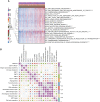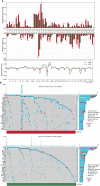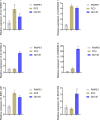Identification of pyroptosis-related lncRNA signature and AC005253.1 as a pyroptosis-related oncogene in prostate cancer
- PMID: 36248980
- PMCID: PMC9556775
- DOI: 10.3389/fonc.2022.991165
Identification of pyroptosis-related lncRNA signature and AC005253.1 as a pyroptosis-related oncogene in prostate cancer
Abstract
Background: Pyroptosis and prostate cancer (PCa) are closely related. The role of pyroptosis-related long non-coding RNAs (lncRNAs) (PRLs) in PCa remains elusive. This study aimed to explore the relationship between PRL and PCa prognosis.
Methods: Gene expression and clinical signatures were obtained from The Cancer Genome Atlas and Gene Expression Omnibus databases. A PRL risk prediction model was established by survival random forest analysis and least absolute shrinkage and selection operator regression. Functional enrichment, immune status, immune checkpoints, genetic mutations, and drug susceptibility analyses related to risk scores were performed by the single-sample gene set enrichment analysis, gene set variation analysis, and copy number variation analysis. PRL expression was verified in PCa cells. Cell Counting Kit-8, 5-ethynyl-2'-deoxyuridine, wound healing, transwell, and Western blotting assay were used to detect the proliferation, migration, invasion, and pyroptosis of PCa cells, respectively.
Results: Prognostic features based on six PRL (AC129507.1, AC005253.1, AC127502.2, AC068580.3, LIMD1-AS1, and LINC01852) were constructed, and patients in the high-score group had a worse prognosis than those in the low-score group. This feature was determined to be independent by Cox regression analysis, and the area under the curve of the 1-, 3-, and 5-year receiver operating characteristic curves in the testing cohort was 1, 0.93, and 0.92, respectively. Moreover, the external cohort validation confirmed the robustness of the PRL risk prediction model. There was a clear distinction between the immune status of the two groups. The expression of multiple immune checkpoints was also reduced in the high-score group. Gene mutation proportion in the high-score group increased, and the sensitivity to drugs increased significantly. Six PRLs were upregulated in PCa cells. Silencing of AC005253.1 inhibited cell proliferation, migration, and invasion in DU145 and PC-3 cells. Moreover, silencing of AC005253.1 promoted pyroptosis and inflammasome AIM2 expression.
Conclusions: Overall, we constructed a prognostic model of PCa with six PRLs and identified their expression in PCa cells. The experimental verification showed that AC005253.1 could affect the proliferation, migration, and invasion abilities of PCa cells. Meanwhile, AC005253.1 may play an important role in PCa by affecting pyroptosis through the AIM2 inflammasome. This result requires further research for verification.
Keywords: immunity; lncRNA; machine learning; prostate cancer; pyroptosis; tumor biomarkers.
Copyright © 2022 Yu, Tang and Li.
Conflict of interest statement
The authors declare that the research was conducted in the absence of any commercial or financial relationships that could be construed as a potential conflict of interest.
Figures









Similar articles
-
A review focusing on the role of pyroptosis in prostate cancer.Medicine (Baltimore). 2023 Dec 15;102(50):e36605. doi: 10.1097/MD.0000000000036605. Medicine (Baltimore). 2023. PMID: 38115248 Free PMC article. Review.
-
Construction and Validation of a Novel Pyroptosis-Related Four-lncRNA Prognostic Signature Related to Gastric Cancer and Immune Infiltration.Front Immunol. 2022 Mar 22;13:854785. doi: 10.3389/fimmu.2022.854785. eCollection 2022. Front Immunol. 2022. PMID: 35392086 Free PMC article.
-
An innovative pyroptosis-related long-noncoding-RNA signature predicts the prognosis of gastric cancer via affecting immune cell infiltration landscape.Pathol Oncol Res. 2022 Dec 7;28:1610712. doi: 10.3389/pore.2022.1610712. eCollection 2022. Pathol Oncol Res. 2022. PMID: 36567977 Free PMC article.
-
A novel pyroptosis gene expression-based risk score for survival in gastric cancer.Front Endocrinol (Lausanne). 2023 Jan 30;14:1120216. doi: 10.3389/fendo.2023.1120216. eCollection 2023. Front Endocrinol (Lausanne). 2023. PMID: 36793271 Free PMC article.
-
Derivation, Comprehensive Analysis, and Assay Validation of a Pyroptosis-Related lncRNA Prognostic Signature in Patients With Ovarian Cancer.Front Oncol. 2022 Feb 24;12:780950. doi: 10.3389/fonc.2022.780950. eCollection 2022. Front Oncol. 2022. PMID: 35280739 Free PMC article.
Cited by
-
Interplay between NETosis and the lncRNA-microRNA regulatory axis in the immunopathogenesis of cancer.J Physiol Biochem. 2025 May 13. doi: 10.1007/s13105-025-01082-x. Online ahead of print. J Physiol Biochem. 2025. PMID: 40358898 Review.
-
AC129507.1 is a ferroptosis-related target identified by a novel mitochondria-related lncRNA signature that is involved in the tumor immune microenvironment in gastric cancer.J Transl Med. 2025 Mar 6;23(1):290. doi: 10.1186/s12967-025-06287-8. J Transl Med. 2025. PMID: 40050892 Free PMC article.
-
A review focusing on the role of pyroptosis in prostate cancer.Medicine (Baltimore). 2023 Dec 15;102(50):e36605. doi: 10.1097/MD.0000000000036605. Medicine (Baltimore). 2023. PMID: 38115248 Free PMC article. Review.
-
LIMD1-AS1 promotes the progression of prostate cancer and affects the function of prostate cancer cells by down-regulating miR-29c-3p.J Cancer Res Clin Oncol. 2024 Dec 5;151(1):5. doi: 10.1007/s00432-024-06046-0. J Cancer Res Clin Oncol. 2024. PMID: 39636414 Free PMC article.
-
LncRNAs and regulated cell death in tumor cells.Front Oncol. 2023 May 29;13:1170336. doi: 10.3389/fonc.2023.1170336. eCollection 2023. Front Oncol. 2023. PMID: 37313458 Free PMC article. Review.
References
LinkOut - more resources
Full Text Sources

